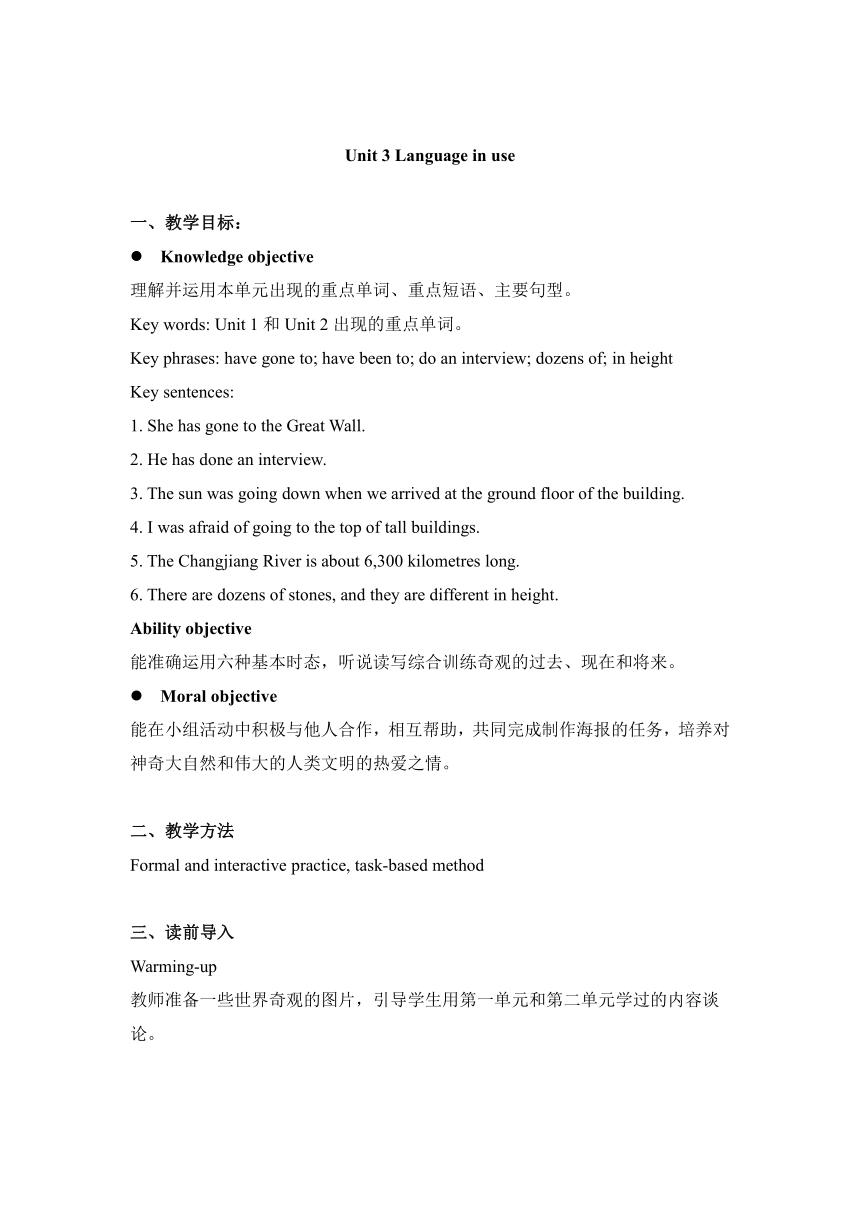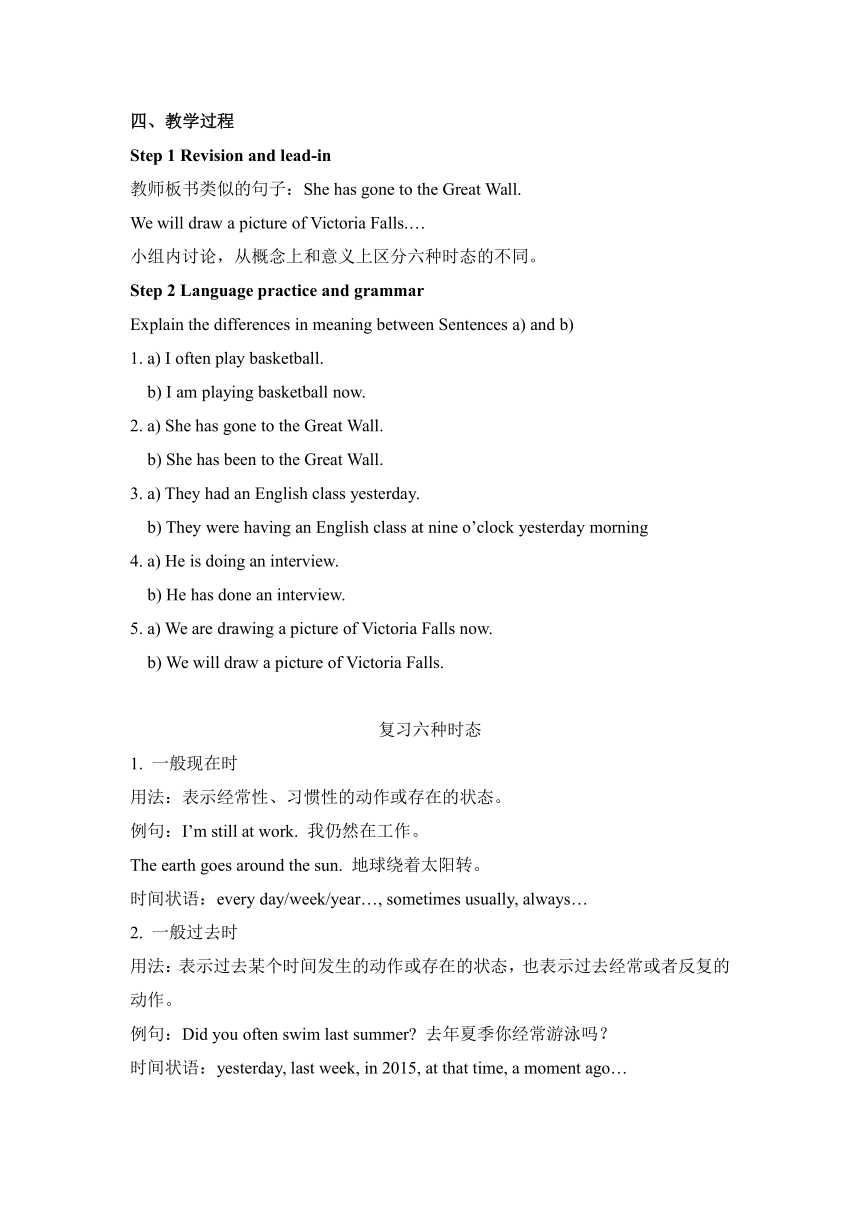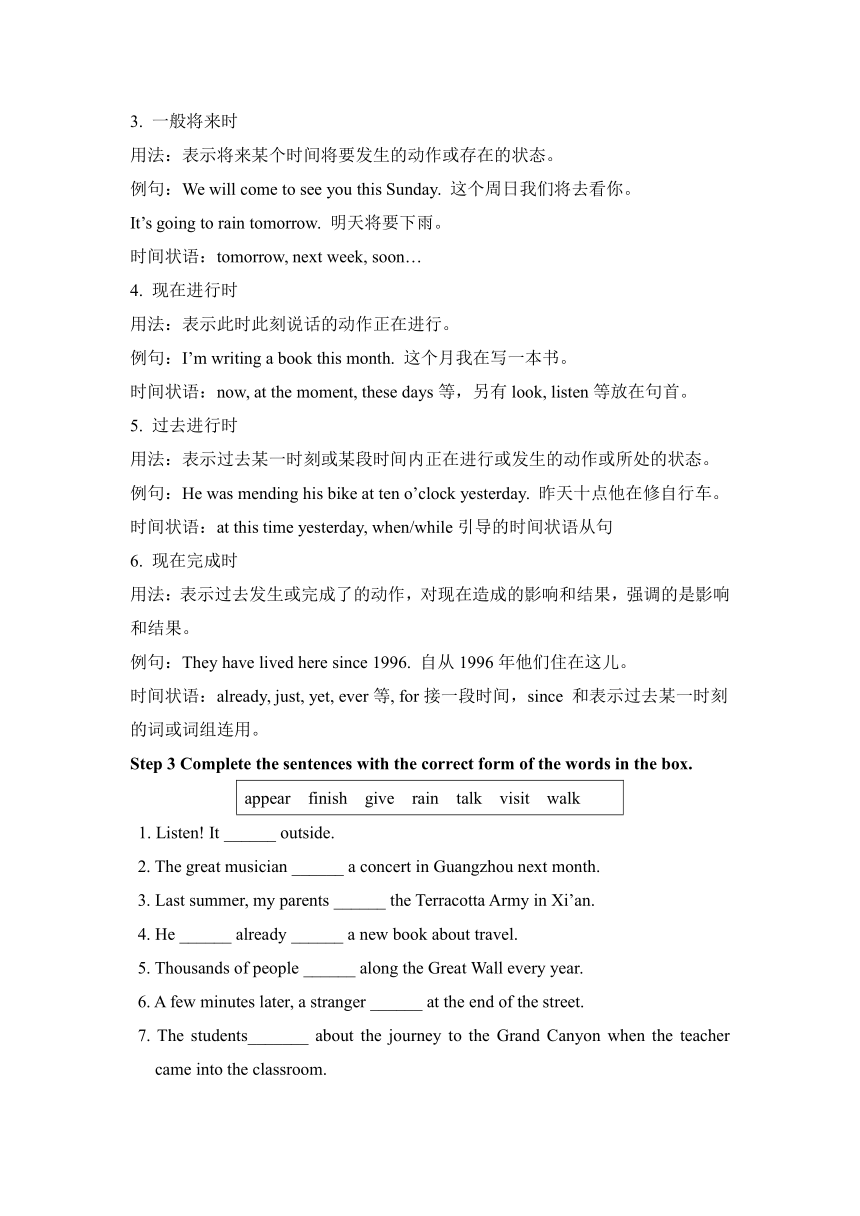外研版九上: Module 1 Unit 3 教案
文档属性
| 名称 | 外研版九上: Module 1 Unit 3 教案 |  | |
| 格式 | doc | ||
| 文件大小 | 74.5KB | ||
| 资源类型 | 教案 | ||
| 版本资源 | 外研版 | ||
| 科目 | 英语 | ||
| 更新时间 | 2020-10-10 11:37:23 | ||
图片预览



文档简介
Unit 3 Language in use
一、教学目标:
Knowledge objective
理解并运用本单元出现的重点单词、重点短语、主要句型。
Key words: Unit 1和Unit 2出现的重点单词。
Key phrases: have gone to; have been to; do an interview; dozens of; in height
Key sentences:
1. She has gone to the Great Wall.
2. He has done an interview.
3. The sun was going down when we arrived at the ground floor of the building.
4. I was afraid of going to the top of tall buildings.
5. The Changjiang River is about 6,300 kilometres long.
6. There are dozens of stones, and they are different in height.
Ability objective
能准确运用六种基本时态,听说读写综合训练奇观的过去、现在和将来。
Moral objective
能在小组活动中积极与他人合作,相互帮助,共同完成制作海报的任务,培养对神奇大自然和伟大的人类文明的热爱之情。
二、教学方法
Formal and interactive practice, task-based method
三、读前导入
Warming-up
教师准备一些世界奇观的图片,引导学生用第一单元和第二单元学过的内容谈论。
四、教学过程
Step 1 Revision and lead-in
教师板书类似的句子:She has gone to the Great Wall.
We will draw a picture of Victoria Falls.…
小组内讨论,从概念上和意义上区分六种时态的不同。
Step 2 Language practice and grammar
Explain the differences in meaning between Sentences a) and b)
1. a) I often play basketball.
b) I am playing basketball now.
2. a) She has gone to the Great Wall.
b) She has been to the Great Wall.
3. a) They had an English class yesterday.
b) They were having an English class at nine o抍lock yesterday morning
4. a) He is doing an interview.
b) He has done an interview.
5. a) We are drawing a picture of Victoria Falls now.
b) We will draw a picture of Victoria Falls.
复习六种时态
1. 一般现在时
用法:表示经常性、习惯性的动作或存在的状态。
例句:I’m still at work. 我仍然在工作。
The earth goes around the sun. 地球绕着太阳转。
时间状语:every day/week/year…, sometimes usually, always…
2. 一般过去时
用法:表示过去某个时间发生的动作或存在的状态,也表示过去经常或者反复的动作。
例句:Did you often swim last summer? 去年夏季你经常游泳吗?
时间状语:yesterday, last week, in 2015, at that time, a moment ago…
3. 一般将来时
用法:表示将来某个时间将要发生的动作或存在的状态。
例句:We will come to see you this Sunday. 这个周日我们将去看你。
It’s going to rain tomorrow. 明天将要下雨。
时间状语:tomorrow, next week, soon…
4. 现在进行时
用法:表示此时此刻说话的动作正在进行。
例句:I’m writing a book this month. 这个月我在写一本书。
时间状语:now, at the moment, these days等,另有look, listen等放在句首。
5. 过去进行时
用法:表示过去某一时刻或某段时间内正在进行或发生的动作或所处的状态。
例句:He was mending his bike at ten o’clock yesterday. 昨天十点他在修自行车。
时间状语:at this time yesterday, when/while引导的时间状语从句
6. 现在完成时
用法:表示过去发生或完成了的动作,对现在造成的影响和结果,强调的是影响和结果。
例句:They have lived here since 1996. 自从1996年他们住在这儿。
时间状语:already, just, yet, ever等, for接一段时间,since 和表示过去某一时刻的词或词组连用。
Step 3 Complete the sentences with the correct form of the words in the box.
appear finish give rain talk visit walk
1. Listen! It ______ outside.
2. The great musician ______ a concert in Guangzhou next month.
3. Last summer, my parents ______ the Terracotta Army in Xi抋n.
4. He ______ already ______ a new book about travel.
5. Thousands of people ______ along the Great Wall every year.
6. A few minutes later, a stranger ______ at the end of the street.
7. The students_______ about the journey to the Grand Canyon when the teacher came into the classroom.
提醒学生注意时间状语和一些关键词的词,学生完成句子,个体汇报,核对答案。
Step 4 Complete the passage with the correct form of the words in brackets.
The sun was going down when we (1) _______ (arrive) at the ground floor of the building. I (2) _______ (be) afraid of going to the top of tall buildings, so I was a little nervous when I (3) _______ (walk) into the lift. The lift (4) _______ (climb) faster and faster until we (5) _______ (reach) the 88th floor. It (6) _______ (be) high up there, but I was not afraid when I stood at the top.
The Jin Mao Tower in Shanghai, one of the tallest buildings in the world, (7) _______ (be) 420.5 metres high. It was built in 1999, and it (8) _______ (have) a fantastic view of Pudong District and the centre of Shanghai. I really like the tower and I am sure I (9) _______ (visit) it again.
注意根据时间状语和句子间的关系判断时态。学生个体汇报,核对答案。
Step 5 Work in pairs. Talk about the wonders of the world you have or have not visited.
A: Have you ever visited the Great Wall?
B: Yes, I have. / No, I haven’t.
A: When did you visit it? / When will you visit it?
B: I visited it five years ago. / Maybe I’ll visit it next year.
Now complete the table.
Wonders of the world When did you visit it? When will you visit it?
The Great Wall
两人一组,口头交流并做好记录,完成表格。
Step 6 Complete the sentences with the correct form of the words in the box. There is one extra word.
教师播放三峡大坝的视频,引导学生造句介绍这一奇观。
ancient high long natural opinion wonder
1. The Changjiang River is about 6,300 kilometres _______.
2. The Terracotta Army is a famous _______ wonder in China.
3. For my homework I have to write an article about the _______ of the world.
4. Mount Qomolangma is the _______ mountain in the world.
5. In my _______, the Great Wall is the greatest man-made wonder in the world.
师生一起浏览方框中的单词,明确意义,然后通读句子,选择单词,核对答案。
Step 7 Complete the passage with the expressions in the box.
agree with at the bottom of go through looking forward to millions of more than
I’m really (1) _____ my visit to the Louvre Museum in Paris. It’s the most visited museum in the world --- every year, (2) _____ people visit it. The Louvre is an old building, but to get inside you must (3) ________ a giant glass pyramid that is (4) ______ 20 metres tall. The entrance to the museum④ is (5) _______ the pyramid. Some people do not like the glass pyramid. They say it looks too new and does not suit the older building. I do not (6) _______ them. I think it looks great!
学生独立选词填空,核对答案,小组内阅读这篇短文。
Step 8 Listening
听前,学生学会猜测图片中的景观名称,然后带着问题听录音,排序。
一层听:Listen and number the pictures.
二层听:Listen again and complete the table.
Mount Qomolangma The Empire State Building The Great Pyramid at Giza
Location Between China and Nepal ________ In Egypt
Height ______ metres ________ metres ______ metres now
Interesting facts First people to climb to the top: Sir Edmund Hillary and Tenzing Norgay _______ floors About ______ years old
Step 9 Work in pairs. Think about three other wonders of the world and talk about them.
A: Where is…?
B: It’s…
A: How high is it?
B: It’s …metres high.
谈论奇观,学生两人一组,部分同学在全班展示。
Step 10 Around the world
一、阅读第一段课文,回答问题:
1. Is Stonehenge a man-made or natural wonder of the world?
___A man-made wonder of the world.________________________
2. Where is Stonehenge?
___In the south of England.__________________
3. How old is Stonehenge?
__ It is about 5,000 years old.______
4. What is Stonehenge used for?
It was probably a place to bury dead people or a place to study stars and the sky at night.
二、阅读第二段课文,判断正(T)误(F)。
(F) 1. There are fewer stones because some of the stones are missing.
(T) 2. No one knows how ancient people move these huge stones from so far without machines to help them.
三、阅读短文,小组内分享巨石阵的信息。
Step 11 Making a poster about a wonder of the world.
1. Work in groups of four. Plan and make a poster about a wonder of the world.
·Decide on the wonder of the world for your poster.
·Find out as much information as you can in books and on websites. Think about:
1) Why should people visit the wonder?
2) What will people see there?
3) How can people get there?
4) How much does it cost to visit the wonder?
5) When is the best time to visit it?
·Make a poster. Find some pictures showing the wonder.
2. Present your poster to the class.
3. 部分学生作品可在墙报、宣传栏等张贴,以增强学生们学习的积极性。
Step 13 Summary & Homework
Summary: In this class, we have learned some phrases and grammar.
Phrases: have gone to/have been to; faster and faster; do an interview; dozens of
Grammar: 复习六种时态
Homework:1.背诵本模块的重点单词和短语。
2.归纳总结本模块的重点句型。
3. 学做一张景观的海报。
一、教学目标:
Knowledge objective
理解并运用本单元出现的重点单词、重点短语、主要句型。
Key words: Unit 1和Unit 2出现的重点单词。
Key phrases: have gone to; have been to; do an interview; dozens of; in height
Key sentences:
1. She has gone to the Great Wall.
2. He has done an interview.
3. The sun was going down when we arrived at the ground floor of the building.
4. I was afraid of going to the top of tall buildings.
5. The Changjiang River is about 6,300 kilometres long.
6. There are dozens of stones, and they are different in height.
Ability objective
能准确运用六种基本时态,听说读写综合训练奇观的过去、现在和将来。
Moral objective
能在小组活动中积极与他人合作,相互帮助,共同完成制作海报的任务,培养对神奇大自然和伟大的人类文明的热爱之情。
二、教学方法
Formal and interactive practice, task-based method
三、读前导入
Warming-up
教师准备一些世界奇观的图片,引导学生用第一单元和第二单元学过的内容谈论。
四、教学过程
Step 1 Revision and lead-in
教师板书类似的句子:She has gone to the Great Wall.
We will draw a picture of Victoria Falls.…
小组内讨论,从概念上和意义上区分六种时态的不同。
Step 2 Language practice and grammar
Explain the differences in meaning between Sentences a) and b)
1. a) I often play basketball.
b) I am playing basketball now.
2. a) She has gone to the Great Wall.
b) She has been to the Great Wall.
3. a) They had an English class yesterday.
b) They were having an English class at nine o抍lock yesterday morning
4. a) He is doing an interview.
b) He has done an interview.
5. a) We are drawing a picture of Victoria Falls now.
b) We will draw a picture of Victoria Falls.
复习六种时态
1. 一般现在时
用法:表示经常性、习惯性的动作或存在的状态。
例句:I’m still at work. 我仍然在工作。
The earth goes around the sun. 地球绕着太阳转。
时间状语:every day/week/year…, sometimes usually, always…
2. 一般过去时
用法:表示过去某个时间发生的动作或存在的状态,也表示过去经常或者反复的动作。
例句:Did you often swim last summer? 去年夏季你经常游泳吗?
时间状语:yesterday, last week, in 2015, at that time, a moment ago…
3. 一般将来时
用法:表示将来某个时间将要发生的动作或存在的状态。
例句:We will come to see you this Sunday. 这个周日我们将去看你。
It’s going to rain tomorrow. 明天将要下雨。
时间状语:tomorrow, next week, soon…
4. 现在进行时
用法:表示此时此刻说话的动作正在进行。
例句:I’m writing a book this month. 这个月我在写一本书。
时间状语:now, at the moment, these days等,另有look, listen等放在句首。
5. 过去进行时
用法:表示过去某一时刻或某段时间内正在进行或发生的动作或所处的状态。
例句:He was mending his bike at ten o’clock yesterday. 昨天十点他在修自行车。
时间状语:at this time yesterday, when/while引导的时间状语从句
6. 现在完成时
用法:表示过去发生或完成了的动作,对现在造成的影响和结果,强调的是影响和结果。
例句:They have lived here since 1996. 自从1996年他们住在这儿。
时间状语:already, just, yet, ever等, for接一段时间,since 和表示过去某一时刻的词或词组连用。
Step 3 Complete the sentences with the correct form of the words in the box.
appear finish give rain talk visit walk
1. Listen! It ______ outside.
2. The great musician ______ a concert in Guangzhou next month.
3. Last summer, my parents ______ the Terracotta Army in Xi抋n.
4. He ______ already ______ a new book about travel.
5. Thousands of people ______ along the Great Wall every year.
6. A few minutes later, a stranger ______ at the end of the street.
7. The students_______ about the journey to the Grand Canyon when the teacher came into the classroom.
提醒学生注意时间状语和一些关键词的词,学生完成句子,个体汇报,核对答案。
Step 4 Complete the passage with the correct form of the words in brackets.
The sun was going down when we (1) _______ (arrive) at the ground floor of the building. I (2) _______ (be) afraid of going to the top of tall buildings, so I was a little nervous when I (3) _______ (walk) into the lift. The lift (4) _______ (climb) faster and faster until we (5) _______ (reach) the 88th floor. It (6) _______ (be) high up there, but I was not afraid when I stood at the top.
The Jin Mao Tower in Shanghai, one of the tallest buildings in the world, (7) _______ (be) 420.5 metres high. It was built in 1999, and it (8) _______ (have) a fantastic view of Pudong District and the centre of Shanghai. I really like the tower and I am sure I (9) _______ (visit) it again.
注意根据时间状语和句子间的关系判断时态。学生个体汇报,核对答案。
Step 5 Work in pairs. Talk about the wonders of the world you have or have not visited.
A: Have you ever visited the Great Wall?
B: Yes, I have. / No, I haven’t.
A: When did you visit it? / When will you visit it?
B: I visited it five years ago. / Maybe I’ll visit it next year.
Now complete the table.
Wonders of the world When did you visit it? When will you visit it?
The Great Wall
两人一组,口头交流并做好记录,完成表格。
Step 6 Complete the sentences with the correct form of the words in the box. There is one extra word.
教师播放三峡大坝的视频,引导学生造句介绍这一奇观。
ancient high long natural opinion wonder
1. The Changjiang River is about 6,300 kilometres _______.
2. The Terracotta Army is a famous _______ wonder in China.
3. For my homework I have to write an article about the _______ of the world.
4. Mount Qomolangma is the _______ mountain in the world.
5. In my _______, the Great Wall is the greatest man-made wonder in the world.
师生一起浏览方框中的单词,明确意义,然后通读句子,选择单词,核对答案。
Step 7 Complete the passage with the expressions in the box.
agree with at the bottom of go through looking forward to millions of more than
I’m really (1) _____ my visit to the Louvre Museum in Paris. It’s the most visited museum in the world --- every year, (2) _____ people visit it. The Louvre is an old building, but to get inside you must (3) ________ a giant glass pyramid that is (4) ______ 20 metres tall. The entrance to the museum④ is (5) _______ the pyramid. Some people do not like the glass pyramid. They say it looks too new and does not suit the older building. I do not (6) _______ them. I think it looks great!
学生独立选词填空,核对答案,小组内阅读这篇短文。
Step 8 Listening
听前,学生学会猜测图片中的景观名称,然后带着问题听录音,排序。
一层听:Listen and number the pictures.
二层听:Listen again and complete the table.
Mount Qomolangma The Empire State Building The Great Pyramid at Giza
Location Between China and Nepal ________ In Egypt
Height ______ metres ________ metres ______ metres now
Interesting facts First people to climb to the top: Sir Edmund Hillary and Tenzing Norgay _______ floors About ______ years old
Step 9 Work in pairs. Think about three other wonders of the world and talk about them.
A: Where is…?
B: It’s…
A: How high is it?
B: It’s …metres high.
谈论奇观,学生两人一组,部分同学在全班展示。
Step 10 Around the world
一、阅读第一段课文,回答问题:
1. Is Stonehenge a man-made or natural wonder of the world?
___A man-made wonder of the world.________________________
2. Where is Stonehenge?
___In the south of England.__________________
3. How old is Stonehenge?
__ It is about 5,000 years old.______
4. What is Stonehenge used for?
It was probably a place to bury dead people or a place to study stars and the sky at night.
二、阅读第二段课文,判断正(T)误(F)。
(F) 1. There are fewer stones because some of the stones are missing.
(T) 2. No one knows how ancient people move these huge stones from so far without machines to help them.
三、阅读短文,小组内分享巨石阵的信息。
Step 11 Making a poster about a wonder of the world.
1. Work in groups of four. Plan and make a poster about a wonder of the world.
·Decide on the wonder of the world for your poster.
·Find out as much information as you can in books and on websites. Think about:
1) Why should people visit the wonder?
2) What will people see there?
3) How can people get there?
4) How much does it cost to visit the wonder?
5) When is the best time to visit it?
·Make a poster. Find some pictures showing the wonder.
2. Present your poster to the class.
3. 部分学生作品可在墙报、宣传栏等张贴,以增强学生们学习的积极性。
Step 13 Summary & Homework
Summary: In this class, we have learned some phrases and grammar.
Phrases: have gone to/have been to; faster and faster; do an interview; dozens of
Grammar: 复习六种时态
Homework:1.背诵本模块的重点单词和短语。
2.归纳总结本模块的重点句型。
3. 学做一张景观的海报。
同课章节目录
- Module 1 Wonders of the world
- Unit 1 It's more than 2,000 years old.
- Unit 2 The Grand Canyon was not just big.
- Unit 3 Language in use
- Module 2 Public holidays
- Unit 1 My family always go somewhere interesting a
- Unit 2 We have celebrated the festival since the f
- Unit 3 Language in use
- Module 3 Heroes
- Unit 1 She trained hard,so she became a great play
- Unit 2There were few doctors, so he had to work ve
- Unit 3 Language in use
- Module 4 Home alone
- Unit 1 I can look after myself, although it won’t
- Unit 2 I became so bored with their orders that I
- Unit 3 Language in use
- Module 5 Museums
- Unit 1 Don't cross that rope!
- Unit 2 If you ever go to London, make sure you vis
- Unit 3 Language in use
- Module 6 Problems
- Unit 1 If I start after dinner, I'll finish it be
- Unit 2 If you tell him the truth now, you will sho
- Unit 3 Language in use
- Revision Module A
- Module 7 Great books
- Unit 1 We're still influenced by Confucius's idea
- Unit 2 It is still read and loved.
- Unit 3 Language in use
- Module 8 Sports life
- Unit 1 Daming wasn't chosen for the team last time
- Unit 2 He was invited to competitions around the w
- Unit 3 Language in use
- Module 9 Great inventions
- Unit 1 Will computers be used more than books in t
- Unit 2 Will books be replaced by the Internet?
- Unit 3 Language in use
- Module 10 Australia
- Unit 1 I have some photos that I took in Australia
- Unit 2 The game that they like most is Australian
- Unit 3 Language in use
- Module 11 Photos
- Unit 1 He's the boy who won the photo competition
- Unit 2 The photo which we liked best was taken by
- Unit 3 Language in use
- Module 12 Save our world
- Unit 1 If everyone starts to do something, the wor
- Unit 2 Repeat these three words daily: reduce, reu
- Unit 3 Language in use
- Revision Module B
